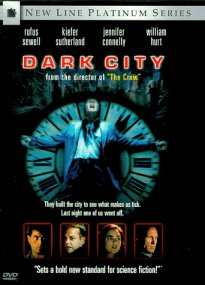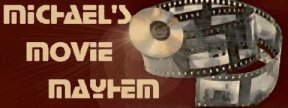|
 How to judge this movie? As a Science Fiction story? Maybe as a film-noir?
Or as a graphical novel? It is all three. How to judge this movie? As a Science Fiction story? Maybe as a film-noir?
Or as a graphical novel? It is all three.
The Science Fiction plot involves humans controlled (unknowingly) by a race of aliens. These aliens remove the
memories of the humans, reconstitute them, mix them up like a jazzed up cocktail drink, and then replant them (mixing
and mis-matching) back into the humans. The city, in which the humans believe they reside, is constantly being
reconstructed and manipulated by the aliens. There is a heavy dose of Philip K. Dick to the plot ("Blade Runner"
and "Total Recall" were based on his Science Fiction writings).
On the film noir side, we have a copper, Inspector Frank Bumstead, played by William Hurt. We have John Murdoch
(Rufus Sewell) who is suspected of ritualistically murdering prostitutes. However, he doesn't remember doing so,
and therefore begins a quest to discover the truth. Let us not forget the dame, a sultry torch singer, Emma (Jennifer
Connelly) who is supposedly John Murdoch's wife. Just to make sure we don't miss the noir side, many of the characters
wear Fedoras, 40's style dresses and suits, and drive 40's cars.
"Dark City" is directed and written by Alex Proyas and filmed by Dariusz Wolski (both worked together
on the movie "The Crow", based on the comics and graphic novels of James O'Barr). It is on this level
that I feel the film works best. It is a richly colored graphic novel. The images, mise-en-scenes, angles, colors, pacing, and
edits, all create the perfect semblance of a "moving" graphic novel. The setups for scene changes in
the film are examples of the panels in a graphic novel that serve the same purpose. The visuals are a wild marriage
of Fritz Lang's "Metropolis", Terry Gilliam's "Brazil", Ridley Scott's "Blade Runner",
and Tim Burton's "Batman". Proyas and Wolski can be justly praised for the look and feel of "Dark
City". Most film critics have rightly done so. However, this alone should not forgive Alex Proyas for some
of the film's shortcomings. Though some film critics have done that.
The acting, on a whole, plays well in both the graphical novel and film noir setting. However, Kiefer Sutherland,
who plays Dr. Daniel Schreber (the sole human working with the sinister aliens), keeps changing his character.
In his opening scenes he affects a halting, sing-song speech pattern that is reminiscent of Peter Lorre. Throughout
the film, Kiefer seems to forget this pattern, only later to remember it, which I found quite disconcerting. Otherwise,
I enjoyed his and the other's performances.
The plot works fairly well (remember it's a graphic novel and not necessarily a masterpiece by Dostoevsky), until
the last 20 minutes of the film. I am a hardcore Science Fiction reader (as some may have noticed by the lack of
the term "sci-fi") and do not take kindly to writers who talk down to their audience. At times, the characters
had to take time away from progressing the storyline to "explain" what was happening, or what it all "means".
For me, this handholding peeled away at the dark and rich atmosphere created by the film. I felt it was akin to
seeing the wires and harnesses on stunt actors. It invaded the total immersion experience. I found the 10 minute
or so (maybe it wasn't that long, but it felt to drag on forever) graphic battle scene between good and evil was
too over wrought. It destroyed the flow of the movie and didn't quite fit in with the style and rhythm developed
in the first 75 minutes. It could have been shortened. I almost suspect that there was still tons of money left
in the special effects budget that needed to be spent. I also felt violated by the "fairy tale" ending.
Hadn't Proyas seen both versions of "Brazil"? The butchered one with the "happy-ever-after"
ending and the one the director fought for? Doesn't he know that in a film noir, one must pay a price for one's
redemption?
Final grade?
As Science Fiction C+ (almost worked, but don't destroy the illusion by telegraphing the subtleties and sub-text
of the plot)
As Film Noir B- (the look and feel was there, but wasn't fully fleshed out)
As a Graphic Novel A- (however, at times the "graphic" part of the movie got in the way of the "novel"
part)
Overall, a B- (since the ending of the film is the last chance to impress or entreat the viewer to the director's/writer's
side, I feel that Proyas squandered the last 20 minutes of an otherwise excellent endeavor)
The DVD
The film is presented in it original aspect of 2.35:1 and is enhanced for 16x9 televisions (and a Pan & Scan
version is available on the flip-side of the disc). The transfer is above average, only wanting at times in sharpness.
The sound is available in English or French 5.1 Dolby Digital (while not spectacular, quite sufficient). Subtitles
are available in English, French, or Spanish.
Extras
2 sets of full length audio commentary
- director Alex Proyas, writers Lem Dobbs and David S. Goyer, cinematographer Dariusz Wolski and production designer
Patrick Tatopoulos
- by Roger Ebert
Comparisons to Fritz Lang's "Metropolis" (1926) (text)
Set designs
"Neil Gaiman" on "Dark City" (text)
Interactive game "To Shell Beach..."
|



